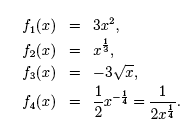|
Definition
A power function is a function of the form,
f(x) = axp,
where a ≠ 0 is a constant and p is a real number. Some examples of power
functions include:

Root functions, such as  are examples of power
functions. Graphically, power functions can resemble exponential or logarithmic
functions for some values of x. However, as x gets very large, power functions
and exponential or logarithmic functions begin to diverge from one another.
An exponentially growing function will overtake a growing power
function for large values of x. On the other hand, growing power functions will
overtake logarithmic functions for large values of x. are examples of power
functions. Graphically, power functions can resemble exponential or logarithmic
functions for some values of x. However, as x gets very large, power functions
and exponential or logarithmic functions begin to diverge from one another.
An exponentially growing function will overtake a growing power
function for large values of x. On the other hand, growing power functions will
overtake logarithmic functions for large values of x.
Domain and Range
The domain of a power function depends on the value of the power p. We will
look at each case separately.
1. p is a non-negative integer
The domain is all real numbers (i.e. (− ∞,∞)).
2. p is a negative integer
The domain is all real numbers not including zero (i.e. (−∞, 0) ∪ (0,∞)
or {x|x ≠ 0}). We will revisit this case when we study rational functions.
3. p is a rational number expressed in lowest terms as r /
s and s is even
A. p > 0
The domain is non-negative real numbers (i.e. [0,∞) or {x|x ≥ 0}).
B. p < 0
The domain is positive real numbers (i.e. (0,∞) or {x|x > 0}).
4. p is a rational number expressed in lowest terms as r / s and s is odd
A. p > 0
The domain is all real numbers.
B. p < 0
The domain is all real numbers not including zero.
5. p is an irrational number
A. p > 0
The domain is all non-negative real numbers.
B. p < 0
The domain is all positive real numbers.
*****
In the next section we will study the graphs of power functions.
Graphing power functions
| 